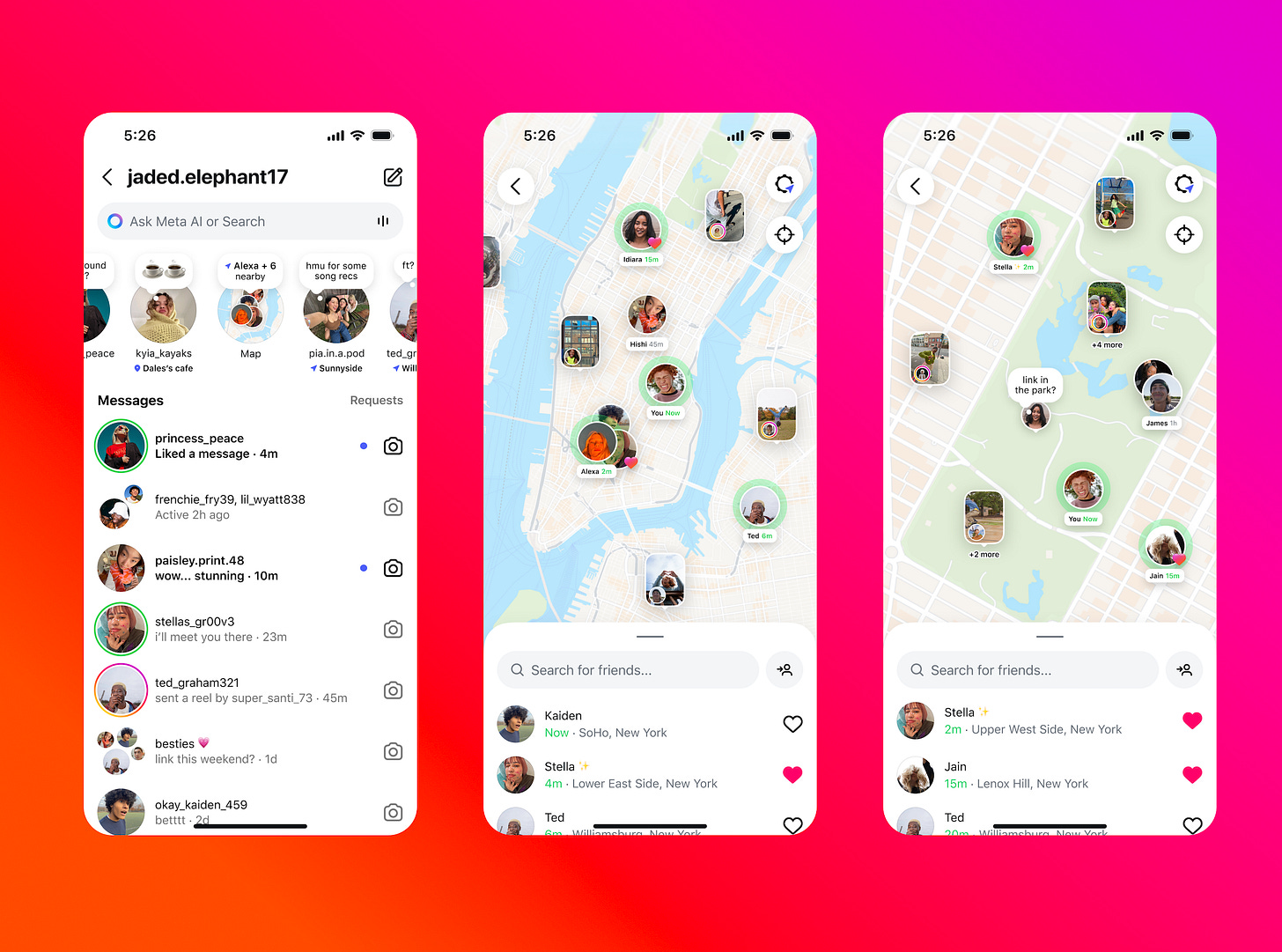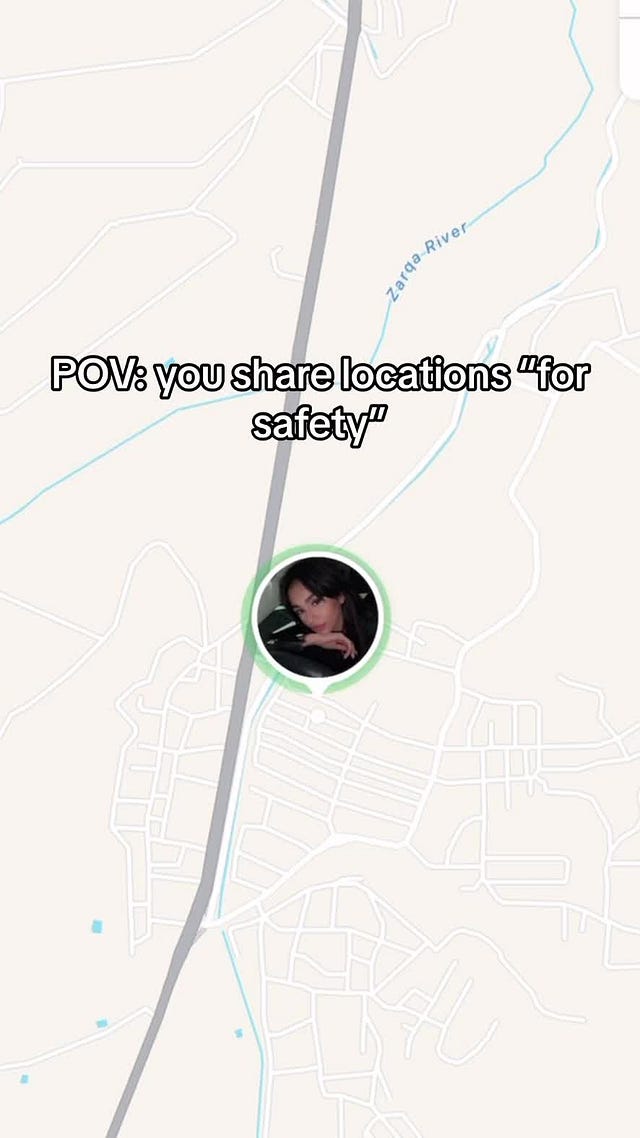The digital world of 2025 is an increasingly dark place—promises of an end-of-history, neoliberal technotopia have foundered on the rocks of monopoly, nativism, and a fractured epistemological understanding of the world. I’ve personally seen the retreat from the “digital public square” to semi-private spaces: group chats, invite-only servers, forums. Some of them are “group chats that rule the world.” Indeed, we seem to be, collectively, past “Peak Social Media.” This week, Julia Kieserman investigates the rise of a different sort of digital private space: social location sharing.
—Hal Triedman, Reboot Editorial Board
“Lighthouses in the Sky”
By Julia B. Kieserman
My brother is a notoriously awful texter. Texts go unacknowledged for days and then weeks, sheepishly answered only when he has stumbled upon a meme, an article, or a funny anecdote he wants to share. While frustrating, there is an honesty to the implicit demand that we make no expectations on his unreliable and often unreachable virtual self. It holds the faintest echo of a time when a landline’s sharp ring cut through the silence of an empty house or a hastily signed postcard arrived mildly battered three months after the fact. It is a declaration of liberation from a shiny piece of alloy, bits of Earth extracted and reconstituted to weigh down our pockets and wear down our fingers. He is not his phone and his phone is not him.
Or at least, it wasn’t him.
A few months ago, he started sharing his location with us, the friends and family who love him. With the flick of a wrist, he absolved himself of the stress of answering the question that location sharing is best suited to answer: where are you right now?
My brother isn’t alone. A 2022 Harris poll found that four in five U.S. adults use location sharing tools like Apple’s FindMy and Google Maps to share their real-time location data with whomever they choose. While we have long known that we are being watched by the advertising industry, the bread and butter business that keeps our tech behemoths afloat, location sharing now puts us in the power seat, allowing us to become the watchers (or the watched) as we silently observe the movements of our friends and family.
To me this immediately raised alarm bells. Having a friend’s location on demand appears to strip them of the very same autonomy that nearly every teenager fights so hard for against their parents. Why is this something we find attractive and how might it be impacting our ability to maintain relationships with one another? In an attempt to answer these questions, I talked to 15 location sharers and polled an additional 67 to discuss how location sharing is part of their lives and understand why they share, who they share with, and what it really means to them to do so.
Like other infrastructure, the Global Positioning System’s (GPS) seeming dullness disguises a mild technological miracle. Accurately rendering each GPS dot on a map requires a roundtrip journey to space, atomic clocks, and communication with no less than three satellites in medium Earth orbit or, as inventor Dr. Ivan Getting put it, “lighthouses in the sky.” To consider it this way is to see it as a bit magical, perhaps the way weary sea travelers see lighthouses on land, or the way the Polaris (also known as the North Star, the spiritual ancestor of GPS) appears to those who turn to it for guidance.
Looking at it—a layer of personal dots on top of a world map—also feels a bit magical, as evidenced by several people who described taking screenshots of maps during a birthday party, marveling at overlapping dots in a central location; their people. To use location sharing is to engage in a cartography well-suited for the modern world. In fact, even though GPS was built with the U.S. military in mind, it is so useful—it’s first civilian use case was aiding commercial aircraft navigation—that it was anointed a dual-use technology, as legitimate in civilian life as it is in military life. Four decades later, the primary functionality of GPS still hasn’t changed: a family taking a cross-country road trip, captains in charge of shipping containers, and a tourist on foot in a new city all turn to GPS with the same questions. In fact, everyone I spoke with used location sharing to consider questions of logistics if nothing else. Where is the friend who left the bar alone? The one running late to dinner? Where is the group I’ve lost at a concert? Where is my mother, navigating herself around my neighborhood?
But when these questions are focused on our own community, the people who love us enough to trust us with their personal location, it quickly becomes more than just a matter of logistics; our brains can’t help but to craft a narrative about what we are seeing. We want to know if our friends make it home from the bar and that our parents are safe because we care for them and we are invested in what happens to them. So we start to speculate: it’s only natural to try and create a story with a limited set of information as a way of sense-making. But how well does this fare when the information we have to craft with is as narrow as a single dot in a moment in time?
Perhaps the most obvious examples of location sharing gone awry are stories of abuse. Two people I spoke with had personal experiences of being harassed through location sharing tools by romantic or potential romantic partners. In one case, GPS was used to first construct an inaccurate and accusatory narrative about a partner’s behavior that nitpicked the details—an impromptu detour to the cafeteria en route to the library was suddenly cause for suspicion—and then to show up unannounced to physically confront them. The experience was harrowing and fundamentally changed the way one woman thinks about sharing her location. She now uses it only for safety and logistics and is far more intentional about where she does and does not want to be seen.
While stories like this one are important examples of the dangers of using location sharing, it can be easy to write them off as edge cases, to assume that this is indicative of dangerous people rather than dangerous technology. And this may be true to some extent. After all, stalking and abusive partners have existed for far longer than location sharing tools have, even if they make bad behavior that much easier. But even those of us with the best of intentions may still get the story wrong.
Consider what happened to Tess, a woman in her mid-twenties living in New York City. On a Friday night out with friends, she lost her phone. Location sharing came to the rescue when she was able to track it to a local police station where it had been turned in. Although the station was already closed for the weekend, she was content knowing it was safe. But Tess is a sharer and her community of watchers, the inner circle she had entrusted with her location, was far less content. They repeatedly called and messaged her to find out why she was locked in a police station. In the absence of any information beyond an immobile dot at a concerning location, narrative inference kicked in and they began to assume the worst. She spent the subsequent two days fielding messages through borrowed devices to notify her friends that it was her phone behind the locked doors of a police station, not her.
For some, myself included, this story might read as a tale of sanctioned voyeurism or even friendly stalking. That the same tool that helped Tess find her phone also made her watchable in this way is what researchers have, perhaps as an ode to its military roots, termed dual-use software. But for Tess, this is a story of caretaking and serves as evidence that she belongs to a community that has her back. This makes sense—should the details have been just a little bit different, she knows definitively that people were ready to jump into action for her. Tess isn’t alone. Nearly everyone who used location sharing believed that interpersonal surveillance—or to put it colloquially, location sharing—is part of an effective safety toolkit. Many people took comfort in the fact that a selection of friends and family were watching them.
This idea isn’t new; late urban activist Jane Jacobs described “eyes upon the street” as an important quality of a safe and healthy city neighborhood. Eyes are what keep well-intentioned people safe and keep the less well-intentioned afraid to act out of line. To some extent, location sharing allows us to redefine our own “street” as dynamic corners around the globe, replacing neighbors, shopkeepers and other “natural proprietors” with our friends and family, however many physical streets apart we may actually be. But it is a fundamentally different approach to safety. With location sharing, we can only see the people we trust, not the ones we worry about. If the assumption is that being surveilled deters bad behavior (which seems to have only a modest effect in practice), then those who we are trying to deter need to know they are being surveilled. This tool doesn’t do that and in its absence, location sharing becomes—except in extreme cases of abduction or missing people—something more akin to a security blanket than a real safety tool. Perhaps fittingly, while nearly all of the people I spoke with felt safer knowing someone was watching to make sure they made it home, none of them had personally found location sharing tools to reveal a friend in crisis. The only exception was one person who had been explicitly instructed by a friend that to see them in a particular location was to see them in a state of distress. But even in this case, location alone wasn’t enough to claim someone was or was not unsafe.

Even Jacobs believed that “there must be a clear demarcation between what is public space and what is private space.” There are spheres of life that should be safe from prying eyes, perhaps because eyes aren’t just watching us, but also changing us. The reason we feel that surveillance works as a safety apparatus is because we believe that we—or someone we are worried about—might behave differently under watch. Sometimes those private behaviors are ultimately quite trivial, like collecting supplies for a surprise birthday party. Other times they might be far more consequential, like going to an appointment at an abortion clinic. Even when the consequences are small, being watched by people we are clearly inclined to share with robs us of the opportunity to do so ourselves which, eventually, can impact the very nature of our relationships.
This was certainly true for Sofia (referred to by her middle name), a professional in her early thirties living in New York City. One evening she was sitting at a bar waiting for her Hinge date when a flurry of texts peppered her screen in a group chat. It was a stream of encouragement, unsolicited drink recommendations for the particular bar she was at and jestful sexual innuendos from her gaggle of single women. She hadn’t told them she was going out but she didn’t need to. She had granted them permission to see her location and they took the opportunity to show up as her background cheer squad. If the date went well and she went back to his place, they would absolutely notice—and have something to say about it. They operated as a modern, tech savvy version of the iconic Sex & The City clique, in part thanks to location sharing.
This is a delightful and powerful way to use location sharing, GPS as a “conversation tool,” which strengthens the bonds between a community of women navigating the often challenging experience of dating in the city. But now, when Sofia reaches for her phone the morning after a date, her friends might already know some pieces of her story, like how late she stayed out and whose home she is waking up in. This might seem small and, as we saw in Tess’ case, it leaves out nearly all of the significant details which could differentiate between the world’s best first date and a mostly negligible evening. But even so, location sharing has created an outline for Sofia to fill in, rather than giving her complete control over the telling of her story. I personally find this a lackluster alternative to a dramatic retelling but this distinction probably has an even more meaningful impact; social penetration theory suggests that a key way to maintain or progress relationships is the act of self-disclosure, repeatedly sharing increasingly intimate details about oneself with another. Perhaps ironically, location sharing can be an effective way to share intimate information but it erodes the experience of disclosure that is so crucial to building relationship trust.
One woman I spoke with admitted to finding this behavior—watching how late a friend is out on a first date—to be a little bit awkward and wrestled with whether to mention what she saw or wait for her friend to bring it up, an acknowledgement of the sometimes squishy norms of how to act (or not) on location information. But nearly everyone believed that these increased “touch points” (a term borrowed from marketing, an industry heavily reliant on surveillance) had a positive impact. In fact they found this to be a valuable feature of location sharing, a way of creating possible connection points that wouldn’t have existed otherwise. People learned of friends spending time in their neighborhood or on an international excursion through location sharing and used it as an excuse to reach out to them. This probably is a useful way to keep in touch and, as one woman pointed out, certainly makes it easier to keep details straight, like the dates and location of a friend’s trip. But it also has—to borrow the term once again—a dual effect on how we interact with each other, both of which remove opportunities for real connection.
Location sharing erases an information boundary, removing the interaction typically required to learn about what our friends are doing. We can see a friend is on a trip “for free,” without having to speak to them at all. At the same time, this information is used to create an additional layer between us and our friends and family. Nearly everyone I spoke to mentioned they would check someone’s location before calling, in case a dot on a map implied (because of course, how could one know for sure) that they were in a location that wasn’t conducive to actually taking a call. Suddenly, because the information existed, people felt uncomfortable not using it as a boundary, thus reducing the frequency of spontaneous interaction. This is to say nothing of the out-group location sharing creates, the lingering luddites who refuse to share location; how long until to fall off someone’s map is to fall out of someone’s life?
I began this journey certain that location sharing was a societal ill. I was convinced that the word “sharing,” a euphemistic wrapper around the real word—tracking—was an intentional choice by technology companies to mask the work of normalizing surveillance behavior in our communities. Talking to a group of people happily or even cautiously sharing location didn’t convince me otherwise. But it did remind me that there is yet another way to define dual-use technology; technology that can be reclaimed by communities to serve their own purposes.
That isn’t quite the location sharing of today. After all, location sharing as we have defined it here is still a framework named for us and provided to us by technology giants like Google and Apple. But maybe there is room for a middle ground, one that acknowledges that location sharing really can create communities of care, drawing invisible lines between friends and families separated by mountains and oceans. It is meaningful that those with no visibility are offered a new way to connect and, while I don’t think it is really making us safer most of the time, it is making us feel safer. Perhaps that should count for something.
This isn’t to make the case that we should readily accept or even make do with what we have, particularly for those of us living in uncertain political environments, where any data point can be weaponized as quickly and casually as a shift in the clouds. But it is to acknowledge that perhaps there is room for a new infrastructure, one not rooted in surveillance capitalism but built from basic human desire. Perhaps the new paradigm moves away from real-time tracking or individual location and towards things like distress signals and collective third places. The power of GPS is still quite magical, but nowhere near as powerful as the magic of humans showing each other care and curiosity. One doesn’t need to steal from the other.
—Julia B. Kieserman is a writer and PhD student in usable security. She likes hanging around books and bulldogs.
🌀 microdoses
“To share or not to share? How location sharing is changing our relationships” (Modern Love podcast)
✨Safety First✨
💝 closing note
If you have an article idea about privacy, security, and/or the changing ideologies of the internet, send me a pitch (hal[at]joinreboot.org)!
— Hal & Reboot team









i loved this essay! loved the part on how disclosure is such a key part of relationship building / trust...have both benefitted from location sharing but also found it to be a really weird and interesting boundary to navigate. <3